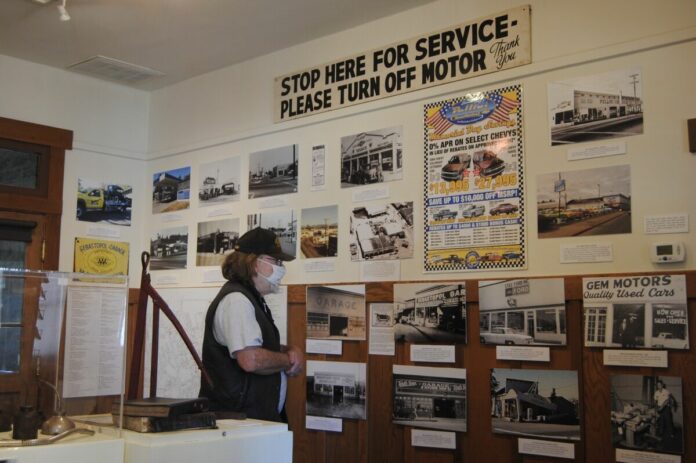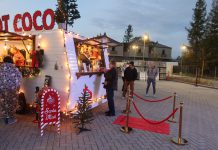Sebastopol wasn’t always the heart and hub of bicycling in Sonoma County. Once upon a time, there were 18 gas stations posted across the little city built for cars, and if you visit the West County Museum, you’ll find that once upon a time spanned most of the 20th century.
The Western Sonoma County Historical Society presents the automotive business history of Sebastopol as its latest exhibit on South Main Street, free of charge and open weekends from
11 a.m. to 2 p.m. at the West County Museum.
Photos of different auto establishments across the 1900s covered walls in the museum, with numbers corresponding to a map key listing their ownership changes over the years beside a chart of the city. Sebastopol was never the center of the county’s car craze back then, but the town boasted Dodge, Ford, Chevrolet and Plymouth showrooms at one time, according to the curator and researcher Mary Dodgion.
In a mid-October interview, she pointed out the exhibit’s other highlights, like a collection of radiator badges and another of hubcaps from the 1910s to the 1920s. On display are old signs and a gas pump farmers would use to fuel their equipment upon delivery, instead of driving tractors out to a gas station.
There’s a poster made of matchbook covers that auto businesses would use for advertising. The hubcaps caught Dodgion’s eye in particular because they were so small, explaining she learned they only became bigger when people realized making tires with less rubber would be cheaper.
Evident in local history is the influence of figures like George “Bud” Polley, who ran a gas station called Polley’s Richfield and then Polley’s Arco on Main Street from the 1960s to the 1980s, and the Pellini family that last owned a Chevrolet dealership where CVS now stands. Polley counted 18 gas stations in Sebastopol in the seventies, Dodgion said.
Only three gas stations remain in the Sebastopol area today — the Chevron off Highway 12, Sebastopol Fast Gas off Gravenstein Highway South and Rotten Robbie on Healdsburg Avenue. According to Dodgion, the Rotten Robbie location has been a gas station under some name since 1932. “And now there’s a moratorium on (new) gas stations. There will be no more gas stations,” she said.
The former owner of Sebastopol Towing stopped by, scanning the photos on the wall and enthusiastically calling out corrections and trivia. Alan Nelson was one of the people who approached the historical society to encourage an automotive exhibit, Dodgion said.
“They missed one,” Nelson announced at one point. He laughed and clapped. “Caught!” The docents shared there were plans to make a book exploring Sebastopol’s automotive history featuring some information from the exhibit. By the sign-in table, a notice invited visitors to pitch in their comments, corrections or whatever they found to be missing.
“It just amazes me how much this town has changed. And every time you look around, it’s taking another change,” he said. Nelson said he owes his strong grasp of the history to his days as a mechanic for the old Ford dealership and towing cars into repair shops, buying gasoline and picking up auto parts as a tow trucker.
Nelson also came out because he happens to own a piece of property formerly used for a gas station, he said, “getting a lot of pressure from the water quality control board to make sure the tanks are out of the ground and stuff like that.”
Dodgion said most walking through the doors to see the exhibit are people ages 50 and above, who remember working at a gas station or could tell what was once around the corner from a street in a dated photo.
“It’s living history in a way, when people come in and share their memories,” said docent Laura Shafer, finding the “continuity of businesses in town especially riveting.”
“It’s like the same building kept changing names and it kept being a car shop, and some of these are still car shops,” she said. “And I also like seeing how there aren’t so many anymore and we have less car stuff, because I think it was very car-centric in the sixties and now we’re trying to make people walk and ride bikes.”
Dodgion mentioned that among other contributors, Sonoma West Times & News provided many photographs prior to being renamed SoCoNews and numerous artifacts were provided by Guy Smith, son of west county historian George Smith.









